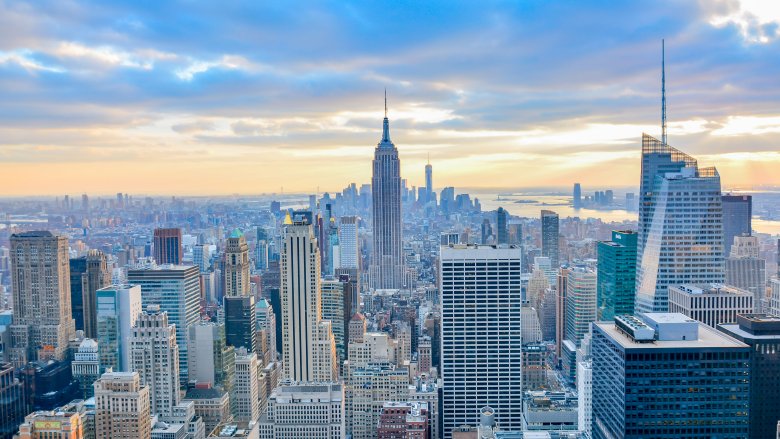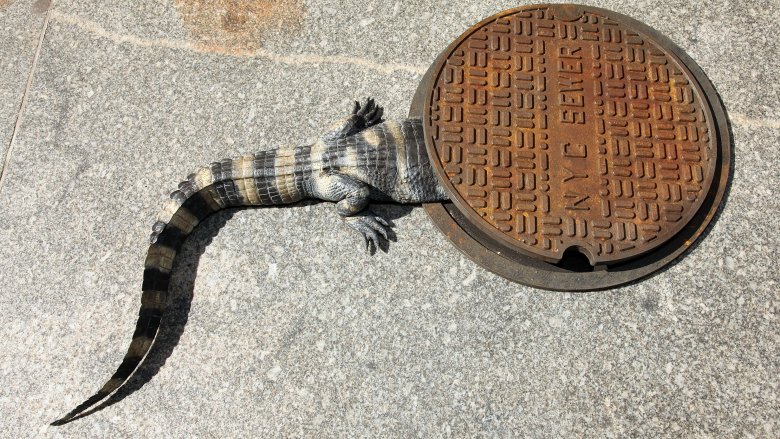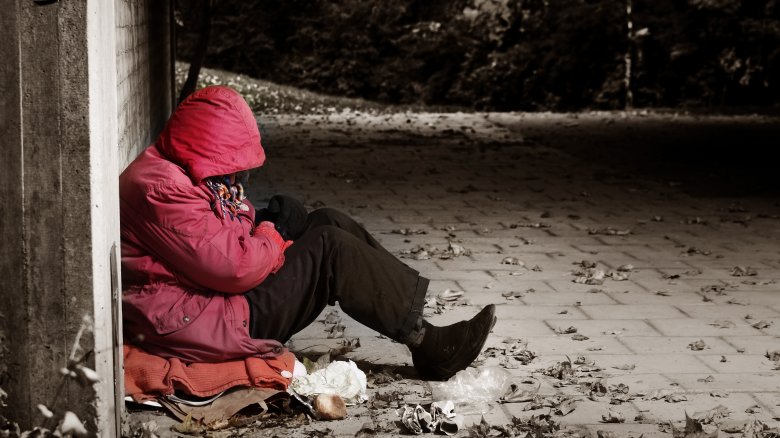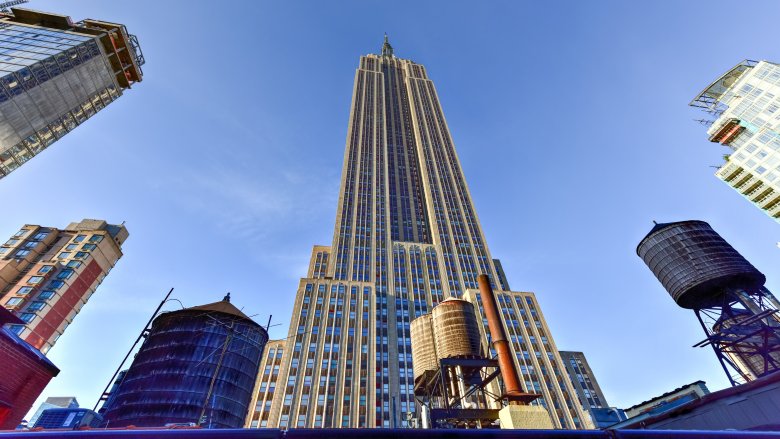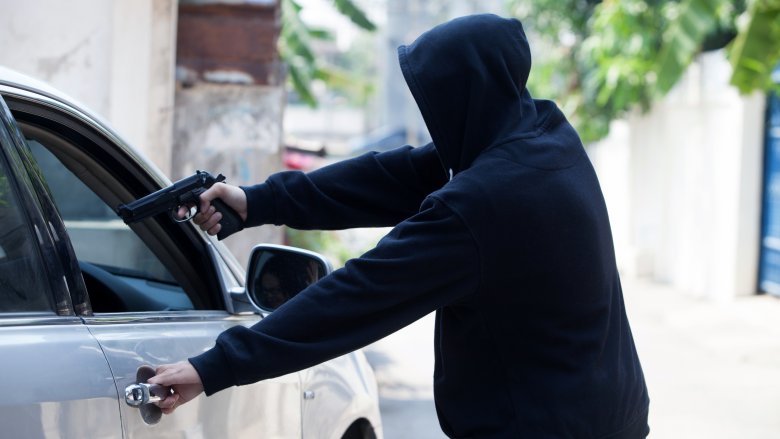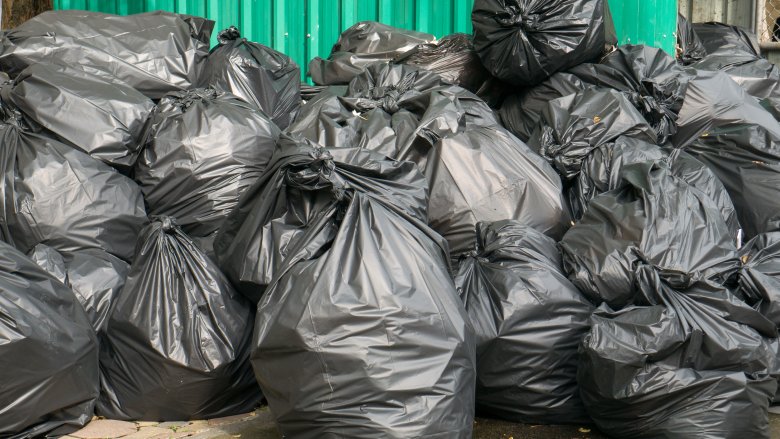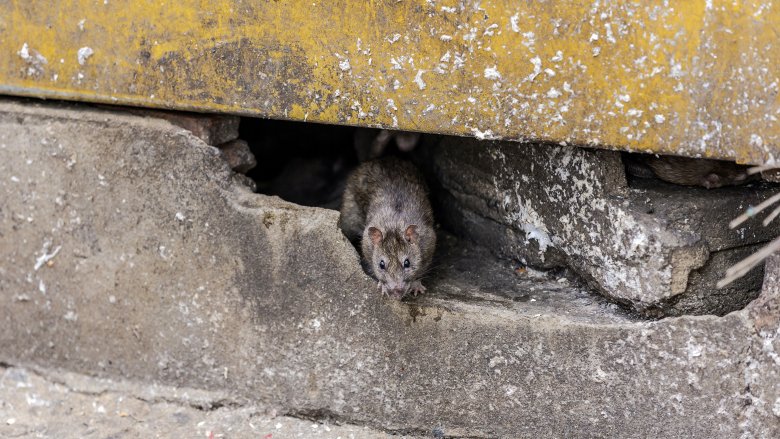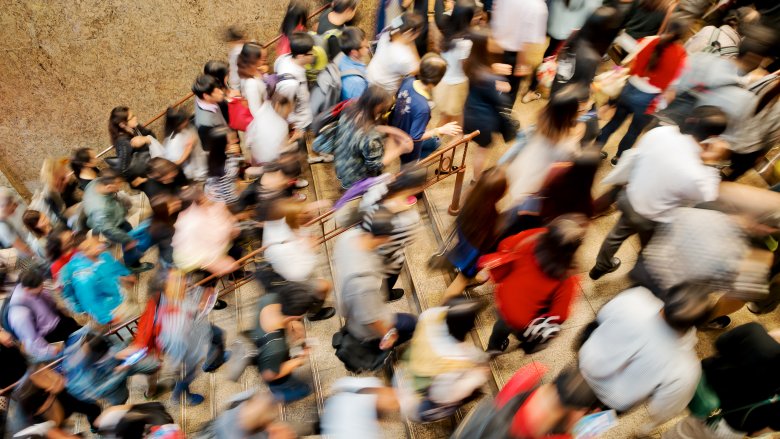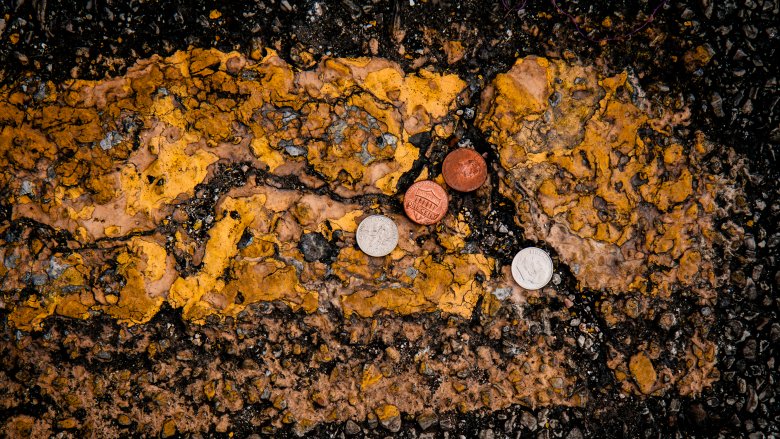False Things You've Always Believed About New York City
New York City. The Big Apple. Gotham. Home to the Trumps, the U.N., and Spider-Man. It's the city so nice they named it twice. It's moved beyond just famous to infamous, and some have argued it's the center of the world. But when you're that important, people are going to start talking about you, and not everything they say is going to be nice.
Lots of rumors have emerged over the years about the city that never sleeps. Some of them are flattering but most, not so much. If they were all true, the place would be even crazier than it actually is. So let's sort the truth from the lies.
There are alligators in the sewers
The New York Times says the rumor that there are dozens, if not hundreds of alligators living in the sewers beneath New York dates back to 1935 when some boys found one and dragged it out before killing it with shovels. And the legend persists, probably because it would be amazing if it were true. One man wants it so badly he celebrates the unofficial holiday "Alligators in the Sewers Day" every February 9.
The rumor was given legs when a 1959 book World Beneath The City made the false claim that sewer inspectors had found tons of the animals and had to kill them in creative ways, including poisoning them and shooting them.
That doesn't mean that no alligators have ever been found in NYC. According to Snopes, over a 90-year period, the New York Times covered 12 different alligator stories, but only one of them involved a sewer and most of them involved alligators that had escaped from much more logical places. In 1937 a man dropped a gator into a garbage can on a subway platform, scaring the poop out of some commuters. In 1932 there was a whole alligator hunt when some boys claimed the Bronx River was swarming with them. (The search turned up empty.) While the occasional rogue alligator will continue to turn up, sadly there will probably never be a colony of them underneath the streets of one of the busiest cities in the world.
The 'mole people' are adapted to their surroundings and coming to get us
The legend that there are huge groups of people living below the streets in the tunnels has been around since at least 1904 when the first subway line opened. The Week says people were obsessed with the idea thanks to stories like Journey to the Center of the Earth. And while there are some homeless people who take refuge underground, most of the rumors about them are more insulting than anything.
And they are aware of what's said about them. One underground dweller who was interviewed said people who venture down there are usually scared of him, and that visitors hear stories about cannibalism. (He also mentioned they believe in alligators in the sewers, for anyone playing NYC myth bingo.) Supposedly the homeless' eyes have adapted to get used to the almost constant darkness. They're said to eat rats. And, of course, they're all going to band together someday and take over the world above.
While some of those rumors might seem more likely than others, they're all equally untrue. They got legs from a 1993 essay called "The Mole People" that went viral before that was even a thing. But then people started pointing out inconsistencies in the stories of a civilization where people were born, elected to office, and harnessing electricity, all underground. As late as 2004, people were still finding flaws in the essay, but by then the myth had taken on a life of its own.
The Empire State Building is the Bermuda Triangle for cars
If you listen to doormen of buildings around the Empire State Building, they'll tell you they see cars that mysteriously won't start all the time. AAA representatives say they tow anywhere from 4 to 15 cars from near there every day. People are sure something weird is going on, and it's known as a sort of miniature Bermuda Triangle.
According to the New York Daily News, the claim is that the huge antenna on top of the building is sending out some kind of signal that messes with cars. (If you're going to just make something up, it would be cooler to go with a death ray, but whatever.) Electric car locks supposedly stop functioning, and some cars stop dead or just won't start. While there are a lot of unsubstantiated claims going around, the people in charge of the Empire State Building deny that their antennas are doing anything wrong.
After the report appeared, the New Yorker decided to do a test, probably the only one anyone has ever bothered to do about this phenomenon. They used an Electrosmog meter, which measures radio-wave pollution, and a compass. They only got a few abnormal readings, and at the base of the building the compass pointed south. Most of the area seemed electrosmog-free, so it probably means that people have just as much car trouble there as everywhere else in the city, but there are a lot of cars there and people notice it more often. Just like the real Bermuda Triangle, it doesn't withstand scrutiny.
NYC is totally dangerous
With so many superheroes calling the place home, there must be huge levels of crime that need taking care of in New York. Pop culture would have you believe there's a masked gunman waiting around every corner. Even Carrie from Sex and the City found herself being mugged for her expensive shoes.
It is true that New York City wasn't always a safe place. It went through some really bad times in the 1970s and '80s, and even as recently as 1990 it saw six homicides a day. But it has come a long way since then. In 2015 it was even found to be the 10th safest city in the world by the Economist's Intelligence Unit (via Business Insider).
The study looked at a wide range of types of safety, not just crime statistics. It surveyed 50 different cities on things like digital security (using rates of things like identity theft), health security (using life expectancy and the ratio of hospital beds to citizens), infrastructure, and personal safety (more traditional metrics of crime). New York was found to be especially good in health security (second place) and digital safety (third place).
Sure, 10th leaves some room for improvement, but it was the highest any American city came on the list. Even the supposedly more idyllic San Francisco only made it to 12th, while Washington D.C. languished at number 19.
It's a big trash heap
Your image of New York probably involves a lot of trash sitting around. And while it's never been voted the cleanest city in the world, the Big Apple is far from a trash heap. Unfortunately, there have been a couple of major garbage strikes there that were epic, and the images sent around the world during those times stuck in the public consciousness.
The first garbage strike was in 1968 and lasted nine days, according to Untapped Cities. It was crazy. The New York Times said it looked like "a vast slum as mounds of refuse grow higher and strong winds whirl the filth through the streets." One writer wrote: "Garbage was piled chest-high. Egg shells, coffee grounds, milk cartons, orange rinds, and empty beer cans littered the sidewalk." But even this was dwarfed by the 17-day strike in 1981. Eventually there would be 100,000 tons of trash sitting out, according to the New York Times. It was hard to get these images out of the minds of the public, but things are much cleaner now.
There are other aspects of New York that make it extra clean as well. Their tap water is so good it has been described as the "champagne of drinking water," according to Curbed. And the lack of garbage isn't the only reason you can breathe deep when you are walking the streets. The New York Times says that in 2013 the air quality was the best it had been in half a century.
You're never more than 6 feet from a rat
There's no doubt that cities, including New York, have lots of rats. Some of those rats have even managed to become internet famous. But there isn't any truth to the rumor that you're never more than 6 feet from a rat, or even that there's one rat per person in the city.
The BBC says these urban legends that are constantly found in news stories date back at least 100 years. They may have originated with a survey about rats in the English countryside, which is about as different from NYC as you can get. In 1909, a book called The Rat Problem said there was one rat per acre of cultivated land in England. Since there were about 40 million acres and there just happened to be 40 million people in the U.K. at the time, this led to the 1:1 comparison. But it had nothing to do with a large American city.
As for the "never more than 6 feet away" rumor, according to The Guardian, the Brit Dr. Stephen Battersby, whose specialty is rat infestations (hey, someone has to be an expert in weird stuff), thought he might have accidentally started that one in an offhand comment he made during an interview in the 1990s. However, the legend's been around a little longer than that, so let's not go crowning Battersby our rat king just yet.
New York is full of jerks
If there's one thing everyone thinks they know about New York City, it's that it's full of mean people just waiting to get to be a jerk to the next person. Whether they're stealing cabs from each other, walking past homeless people, or yelling at each other over any little thing, pop culture has told us that it's full of up-themselves a-holes. But when you actually get there and start interacting with the locals, you might find this to be totally untrue.
In 2006, Reader's Digest (as relayed by NBC News) decided to settle once and for all which was the nicest city. They sent in undercover nice-detectors to see how many people passed a "courtesy test." Four of five New Yorkers passed with flying colors and it was named the nicest city in the world of the 36 cities tested in 35 countries.
In 2012, CNN gathered together some nice things New York had done recently, including helping after Hurricane Sandy and no one killing anyone else for a whole day. (Sure, that isn't hard for lots of places, but most places don't have as many people as New York.) One writer for the Smithsonian thinks the reason outsiders think New Yorkers are rude is they treat everyone as if they know them. That means they'll be happy to give you directions but will also call you out if they think you're doing something wrong. But it comes from a place of understanding.
A penny dropped from the Empire State building can kill a person
You're on the trip of a lifetime. You finally made it to Manhattan and you've spent way too much to go up to the observation deck of the famous Empire State Building. You are, almost literally, on top of the world (minus a handful of other skyscrapers and that darn Everest). But the sudden power goes to your head. You look down at the people milling around below like ants. How easy would it be to "accidentally" flip a penny over the side and plonk one of them?
Everyone has heard that dropping a penny from the Empire State Building will drill right through someone's skull, but then boring scientists actually looked into it. According to Scientific American, one guy tried to replicate what the fall from a skyscraper would be like using wind tunnels. In the end, the pennies that did hit him didn't hurt much. It's that there's too much air pressure slowing the flat coin down on the drop. If it was in a vacuum, sure, you'd be dead, but it's not.
Business Insider says the Mythbusters went a step farther and built their own gun that would fire pennies at the same speed as they would fall from the building: 64.4 miles per hour. That sounds fast, but the most they got was a slight stinging sensation. If you're going to pick a moment to go all comic book villain, atop the Empire State Building isn't the right place.
Manhattan was purchased for $24 worth of beads
One of the first urban legends about New York comes from before it was even a city. Every child learns in school that the Dutch bought the whole island of Manhattan for $24 worth of beads. It shows how awful the settlers were in taking advantage of the natives, and it makes Native Americans look stupid, like they didn't know how much the land was worth.
There are a few problems with this myth. The National Museum of the American Indian says that the settlers might actually have been duped and paid a tribe that didn't even live on Manhattan. Or the Native Americans might have thought they were just being paid for safe passage through the land, not thinking they were giving it away entirely.
Then there's the whole $24 in beads thing. According to Untapped Cities, the number comes from a miscalculation a historian made way back in 1846 and people have just been repeating it ever since. In reality, they probably got more like the modern equivalent of $15,000 for the island. And while they might have gotten some beads, they more than likely got some much more important tools as well. When the Dutch bought Staten Island years later, we know they gave the natives things like kettles, axes, hoes, drills, and even musical instruments. The problem is items like this are often referred to as "trinkets," which makes them sound like cheap tat rather than the very useful items they were. Still probably cheap for a whole island, but not just peanuts.
